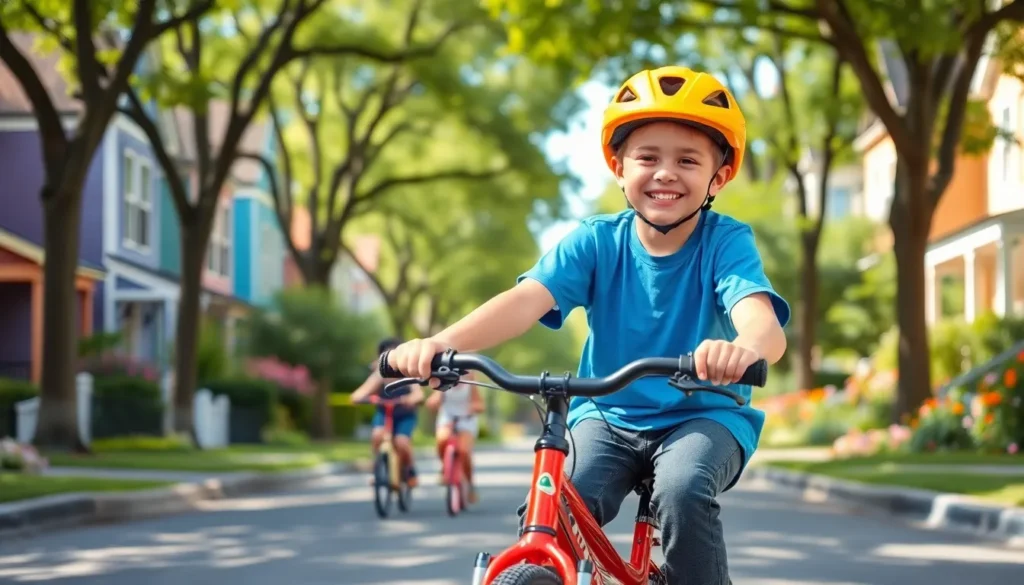Table of Contents
ToggleCycling isn’t just a fun way for kids to get around; it’s a ticket to adventure, freedom, and maybe even a few scraped knees. As they zoom down the street with the wind in their hair, kids discover the joy of independence while getting a workout that doesn’t feel like a chore. Who needs a gym membership when you’ve got a bike and a neighborhood full of friends?
Benefits Of Kids Cycling
Kids cycling offers numerous benefits that enhance overall growth and development. Engaging in biking fosters a sense of adventure and freedom while promoting physical and mental health.
Physical Health Advantages
Cycling improves cardiovascular fitness and builds strength. Regular bike rides develop muscle in the legs, arms, and core. Engaging in this activity encourages weight management, as biking burns calories effectively. Research shows that children who cycle regularly have a lower risk of obesity. Enhanced coordination skills result from balancing and maneuvering a bicycle. Strong bones and joints also benefit from this low-impact exercise.
Mental Well-Being Benefits
Cycling contributes positively to children’s mental health. Riding a bike allows kids to relieve stress as they explore new environments. Daily cycling can improve mood and reduce anxiety by increasing endorphins, the body’s natural mood boosters. Developing social skills occurs when children ride with friends. Increased confidence stems from mastering bike skills and exploring independence through cycling.
Choosing The Right Bike

Selecting the right bike ensures a comfortable and safe experience for kids. Factors like size, fit, and type significantly influence the choice.
Size And Fit Considerations
Proper bike size is crucial for safety and control. Kids should be able to reach the handlebars comfortably while keeping both feet on the ground. An easy way to determine fit is to test the bike. Sit on the seat; a slight bend in the legs while pedaling signifies an appropriate size. Adjusting the seat height can accommodate growth, highlighting the importance of periodic checks. Always prioritize models that allow for minor adjustments to enhance their suitability as children grow.
Bike Types For Different Ages
Matching bike types to ages improves enjoyment and safety. Balance bikes serve toddlers, focusing on coordination without pedals. As kids reach ages 4 to 6, 16-inch bikes often make an ideal choice, offering training wheels for added stability. Bikes designed for ages 6 to 12 generally range from 20 to 24 inches, fitting their growing independence. Older kids benefit from models equipped with gears and hand brakes, aligning with their increasing confidence and skills. Choosing the correct bike type significantly enhances ride quality and encourages ongoing engagement.
Safety Tips For Kids Cycling
Ensuring safety while cycling enhances both enjoyment and confidence for kids. Following established guidelines helps create a secure environment for young riders.
Essential Safety Gear
Wearing a properly fitted helmet significantly reduces the risk of head injuries while cycling. Protective gear like knee and elbow pads offers additional safety for falls. Wearing bright or reflective clothing increases visibility to motorists and other cyclists. Using lights or reflectors on bikes improves nighttime visibility. Ensuring that bikes feature working brakes and proper tire inflation contributes to overall riding safety.
Riding Rules And Precautions
Adhering to traffic signals is crucial for safety, as it promotes awareness of surroundings. Riding on designated bike paths and sidewalks, when available, minimizes risks. Teaching children to signal turns clearly helps communicate intentions to others. Staying alert to nearby pedestrians and other cyclists fosters a safer environment. Practicing in low-traffic areas builds confidence before venturing into busier streets.
Encouraging Your Kids To Cycle
Encouraging kids to cycle enhances their enjoyment and engagement with the activity. Involving them in various fun approaches increases their excitement about biking.
Setting Up Fun Challenges
Establishing fun challenges can motivate kids to cycle more frequently. Parents can create simple obstacle courses in the backyard or at a local park that engage children’s skills. Timing competitions or organizing scavenger hunts can make these challenges even more thrilling. Kids enjoy discovering new routes, and implementing friendly races among friends promotes camaraderie. Regularly changing the challenges keeps interest levels high and ensures biking remains a fun, engaging activity.
Organizing Family Cycling Trips
Planning family cycling trips strengthens bonds and encourages kids to enjoy the outdoors. Select scenic routes that accommodate different skill levels to ensure everyone feels comfortable. Visiting parks, lakes, or nature trails offers opportunities for exploration and adventure. Bringing snacks for breaks enhances the experience, allowing families to rest while discussing fun biking moments. Establishing a routine of monthly or seasonal cycling trips ensures kids look forward to spending active, quality time with family.
Cycling offers kids an incredible opportunity to explore their surroundings while reaping numerous physical and mental benefits. It encourages independence and fosters social skills as children ride with friends.
Selecting the right bike and ensuring safety are crucial for a positive cycling experience. With the right gear and knowledge of safety practices, kids can enjoy their rides confidently.
Parents can further enhance their children’s cycling journey by incorporating fun activities and family outings, making biking a cherished part of their lives. Embracing cycling not only promotes a healthy lifestyle but also creates lasting memories for families.




